Across and Between Cultures: Reflecting on Transcultural Collaboration 2023
教學工坊
2024-01-10
By: Leo Barton
The concept of transculturality is complicated. Not only does it challenge traditional notions of cultural boundaries, but it is incredibly elusive and often difficult to differentiate from similar terms. The Transcultural Collaboration (TC) program aims to bring these complexities into focus through direct experience, exploration, and collaboration. From Summer to Winter 2023, the program brought together 25 students from over ten leading arts universities from the Shared Campus network to do exactly that in Zurich, Switzerland and Taipei, Taiwan.
In this piece, I will share my experience of the TC23 program. Outlining the variety of exciting and enriching experiences I had over its three-months.
Double International
For context, a little bit about myself. I am an international student from the UK, currently in my second year of the International Masters in the Cultural and Creative Industries, in the department of cultural resources at TNUA. While my background is in filmmaking and film theory, I am currently working in the world of new media as a game designer and digital artist.
Across my academic career, international experience has always been a focus. During my bachelor’s degree I travelled to Seoul, Chengdu and Hamburg for various programs ranging from summer schools to a year-long exchange. These experiences were, by far, the most enriching and memorable moments of my degree—prompting both my study in Taiwan and my participation in the TC program.
TC was particularly interesting for me in my current circumstances, as it gave me the opportunity to put down my academic work for a semester to focus on my artistic practice. More specifically, exploring that practice alongside a vibrant and diverse group of peers from a variety of disciplines.
So I went for it, applying for the program with a clear and honest statement regarding my current interests, practice and research in both art and transcultural collaboration. After a friendly interview, I was, fortunately, chosen to participate in TC23. Then, after securing promise of some financial support from TNUA’s office of international affairs, I prepared myself for Zurich.
I’m very grateful with how the team provided support in the lead up to the start; providing more affordable options for (self-paid) accommodation in Zurich, along with plenty of recommendations and guidance. It’s worth noting that, because the second half of the program took place in Taipei were I already had accommodation, the program also organised (self-paid) accommodation in Taipei for participants.
Transcultural Explorations
Zurich

Figure 1: The very European view from my rental apartment, Zurich.
Touching down in Europe after a year away was both exciting and challenging. After settling into the accommodation, I quickly indulged in a whole host of foods that are hard to find in Taipei. Good bread, strong cheeses, middle eastern dishes and more. I have fond memories of chowing down on such goodies, sitting on my rental apartment’s sun-kissed balcony—a truly idyllic image of Europe.
Then came a defining moment: the first day at Zürcher Hochschule der Künste (ZHdK). Despite the fact that all participants were incredibly talented and caring individuals, we were all most certainly a little nervous. Fortunately, a combination of sensitive group-building exercises and our buzzing excitement cut through the nerves relatively quickly.
The Zurich portion of the program was split into two clear phases: exploration and experimentation.
First, we dove deep into the key topics of the program: transcultural, collaboration and, this edition’s focus, protection. We unpacked each of these concepts, and more, through a variety of classroom activities, guest lectures and local field trips. Resulting in a productive coming-together of ideas, cultural backgrounds and perspectives. While many of us came from different discursive traditions, the group was careful and conscientious to always leave space for every voice to be heard.
Second, we dove into our practical group experiments. Led by mentors, we formed small, intermixed groups and began undertaking a short two-week project to exhibit in ZHdK. As opposed to the first part, this phase was largely self-directed. Allowing us to set our own goals and schedule while receiving tonnes of administrative and resource help from TC team.
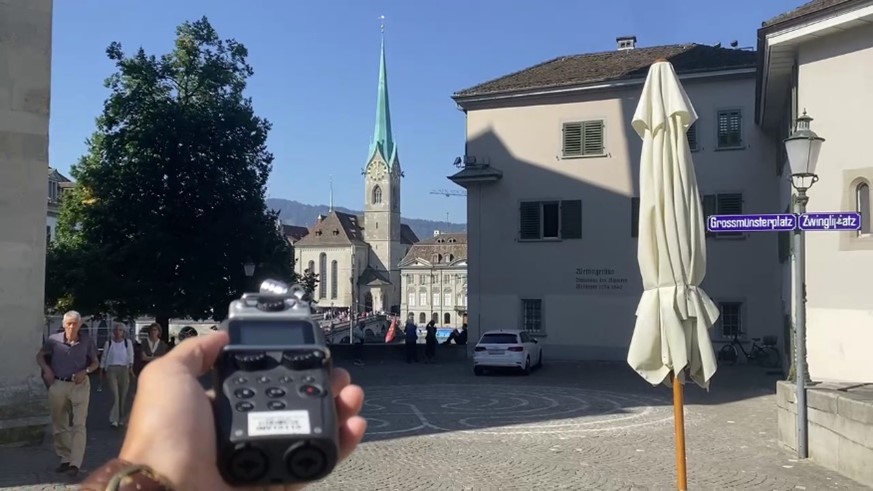
Figure 2: Recording audio on location in Zurich, Switzerland.
With our piece finished and the mini exhibition over, our time in Zurich was up, but TC23 still had much more to give.
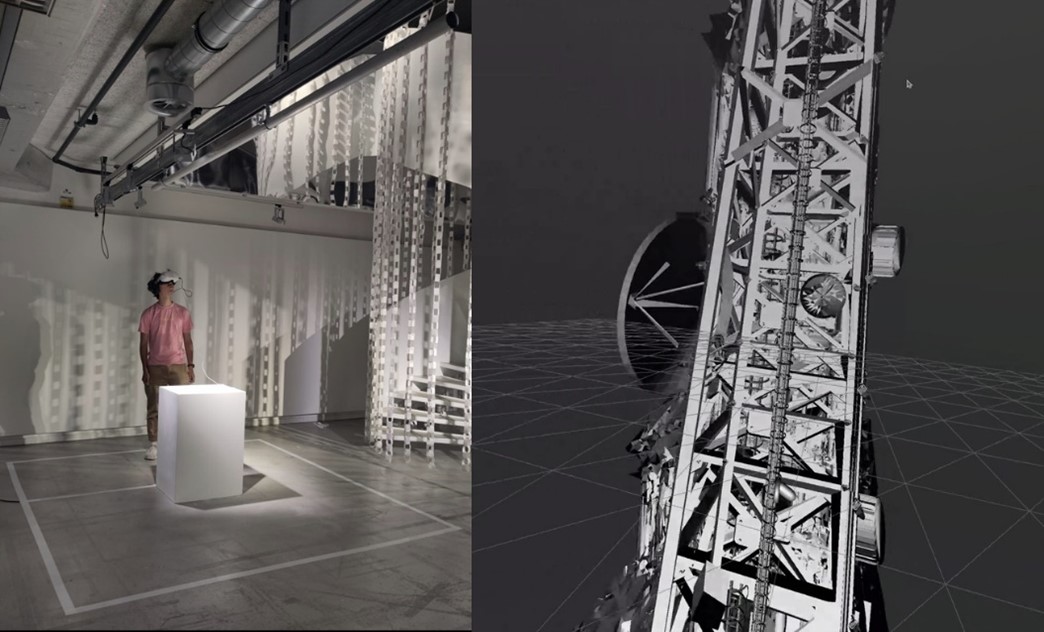
Figure 3: "Approaching Tower" in Exhibition. ZHdK, Zurich, Switzerland. September 2023.
Taipei
During the epic sixteen-hour journey from Zurich to Taipei, I travelled alongside my colleagues on my flight, meeting even more during transit in Dubai and on touchdown in Taipei. I was incredibly excited to arrive back in Taipei, to share and re-explore this city that I have such an adoration for. As we came together, I felt the energies of the group reinvigorated by the new city—for many it was their first time here, for some their first time in Asia! This energy propelled many explorations and discussions both on and off campus.
The Taipei portion of the program was split into three phases: exploration, field trip and realisation.
Much like in Zurich, we started with classes, workshops, field trips and discussions on campus and around Taipei. While the cohort organised an immeasurable number of outside activities to explore the city and Taiwan. This phase culminated in us finding our groups within which we would create a final artwork to exhibit at C-Lab.
Before diving deep into this final stage of the process, breaking down our process and intentions, it’s worth mentioning our week-long excursion to Orchid Island and Taitung. This trip was organised to accompany and expand our discussions of transcultural, putting us in direct contact with indigenous groups in both locations. After a seasickness fuelled boat ride to Orchid Island, we spent five days exploring and exchanging with the various Tao communities around the island. Acting as a refreshing third space, heavily contrasting Zurich and Taipei, the trip provided a wealth of new experiences for the group—both together and conceptually. Many teams directly used this experience as the fuel for their final pieces; for example exploring environmental issues, colonialism and unique materials. The journey to Orchid Island was one of the most unique opportunities of the TC program, given that it was orchestrated by researchers of indigeneity at TNUA. Offered us the rare opportunity to meet and exchange with cultural leaders in both Taitung and Orchid Island—something which would likely be impossible to do by oneself.
Towards – living traces –
The journey towards creating my group’s final piece, – living traces –, began by connecting as a group through shared interests found within the guiding terms of “body mythology”, “consciousness”, “reproducibility”, “physical computing”, “collection as protection”, and “the threshold between life and death”. Once formed, we endeavoured to continue exploring these topics, alongside others we had encountered during the program.
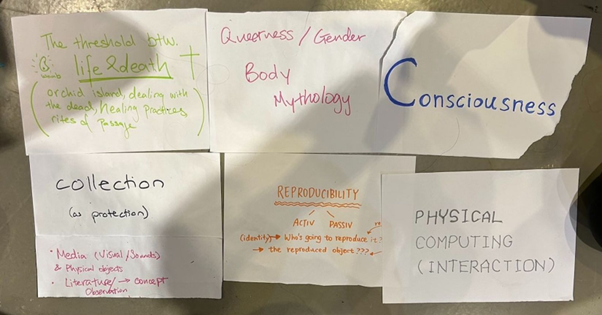
Figure 4: Group-building terms.
These explorations were conducted in a variety of ways, from discussion sessions, workshops and associative thinking tasks to, much like in Zurich, field trips. Three field trips in particular were fundamental to the formation of our final work. These were visits to the public community-run hot spring in Wulai, the Beihai Fuzuo cemetery (北海福座) and the aforementioned trip to Orchid Island.
While the trip to Wulai originally served as the backdrop for team-building and creative workshop, as we descended towards the community-run hot spring dug into the riverbank it quickly became clear that this would be a rich experience of cultural exchange. We were welcomed warmly—pun intended—by the group of locals camped out around the hot spring talking, eating, and drinking tea. And we were invited to dip in the soothingly warm waters of the spring. While this experience was rich and memorable, the context of the space is what interested us greatly. On the rock wall was a message board reading “we invite friends from all over the world, tourists, to cherish this valuable secret place by taking photos. But please do not post and mark the exact location.”
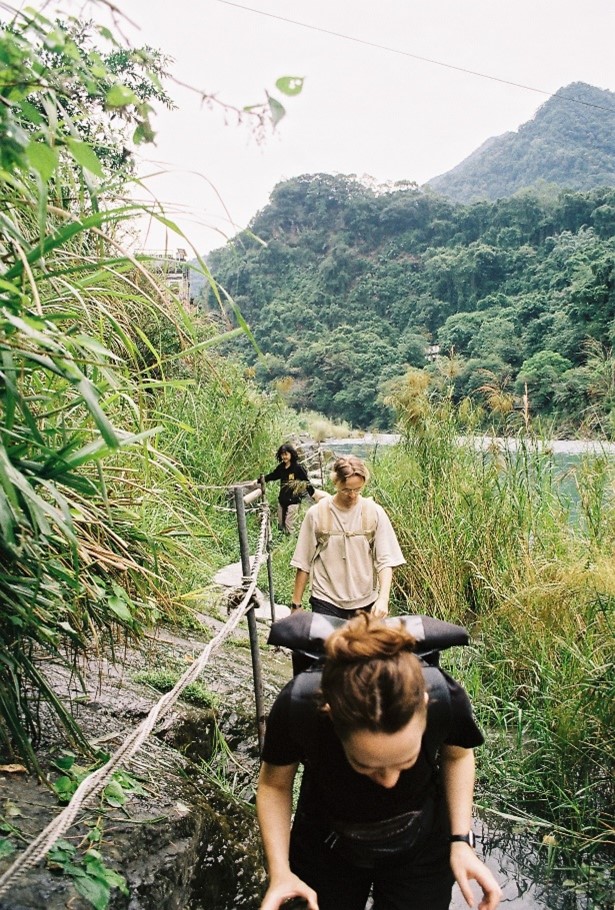
Figure 5: Hiking to the hot spring, Wulai, Taiwan.

Figure 6: Sign on the rock wall of the public Wulai hot spring.
The continued existence of this hot spring, and its clear desire to remain somewhat unmarked (despite being widely known) returned us to the concept of cultural identity as something that is self-defined and fought for when under threat. But what was particularly notable about this example, was its embrace of the transcultural. Locating itself as a somewhat illegal refuge for a traditional approach to hot springs, while simultaneously openly embracing international attention and visitation, in our eyes, this was an open act of transcultural protection in the face of a local threat. Displaying how the preservation of this cultural locale has a lot to offer the world; both in upholding tradition and offering physical respite. Creating a cultural experience, and memory, that extends beyond the local community.
Our second impactful trip found us at the Beihai Fuzuo cemetery (北海福座) north of Taipei. Through this trip we wanted to interrogate the topic of remembrance. This cemetery was chosen precisely because of its transculturality. Standing many stories tall, this cemetery towers over its mountainous locale with traditional family tombs surrounding it. But it is what was inside that intrigued us. As you travel floor-to-floor through the vertical cemetery, you traverse different religions, belief systems, social classes and more. Certain floors are demarked for Buddhists, Christians, or Taoist burials while many are also differentiated by prestige. This literal stacking of belief systems atop one another felt like a true symbol of transculturality. The boundaries were laid out to make space for differing beliefs and traditions, while they were, quite literally, all placed together into one greater whole.
Of course, tombs within this impressive, modern cemetery do not come cheap. While the staff would not disclose specific prices to us, internet searches revealed that prices ranged from NT$200,000 to over $1 million, not including the costs of funeral proceedings, offerings, cremation and the like. These compare to average monthly wages of NT$57,728. Beside financial barriers to entry, floors are organised in a flipped hierarchy—larger, grander and lavishly named tombs near the bottom and smaller, simpler tombs near the top. Thus, if this were to be an icon of transculturality, it would imply a hierarchy of finances—something I will return to later.
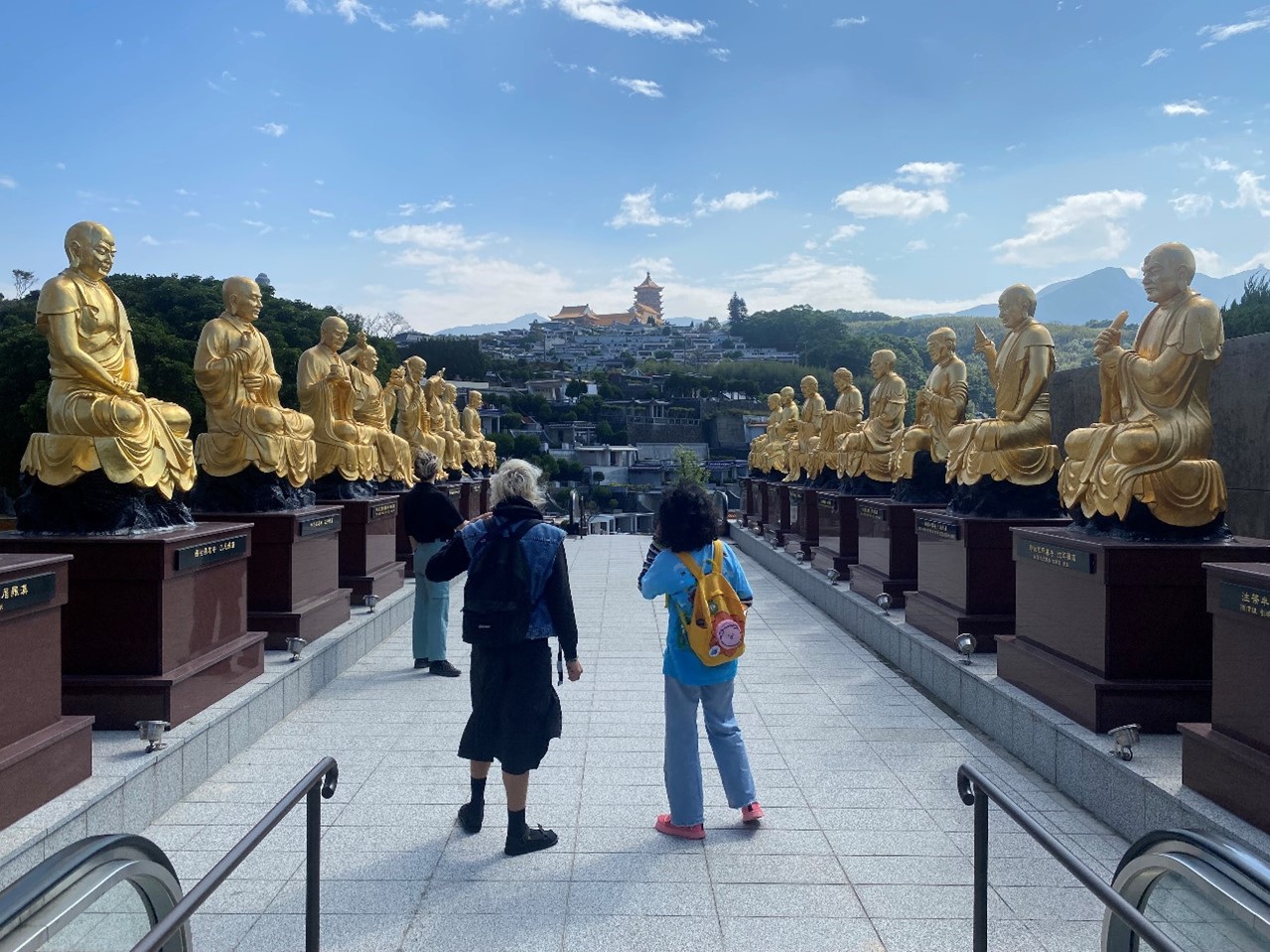
Figure 7: At Beihai Fuzuo cemetery
Third came the 5-day excursion to Lanyu, Orchid Island or Pongso no Tao, depending on your choice of the Chinese-language name, its anglicisation or the native name given by its resident Tao people. Through the various talks, meetings, and observations we were exposed to and influenced by a lot. Beyond the kindness of the people and the glory of the natural environment, one of the strongest sentiments that stayed with me was a passing comment provided by a speaker along the lines of “over the last 20 years there have been more anthropologists on Lanyu than locals”.
This sentiment urged me to reflect on our position—international artists and students travelling to a remote indigenous community to study their ideologies, traditions, and beliefs in order to take them away in our minds and craft them into works that would be credited to us. While this thought provoked debate, such a debate appears endlessly cyclic with both options—to travel and study or to remain distant but welcoming—being justified under a lens of transculturality. With the ultimate question being, how can we ensure that transcultural exchange doesn’t replicate many of the hierarchies of power instated by the colonial system—if it doesn’t do so already?
These ideas of communities extending beyond the physical and temporal, the hierarchies of transculturality and the positioning of oneself within a transcultural system became some of the largest questions we wanted to address in – living traces –.
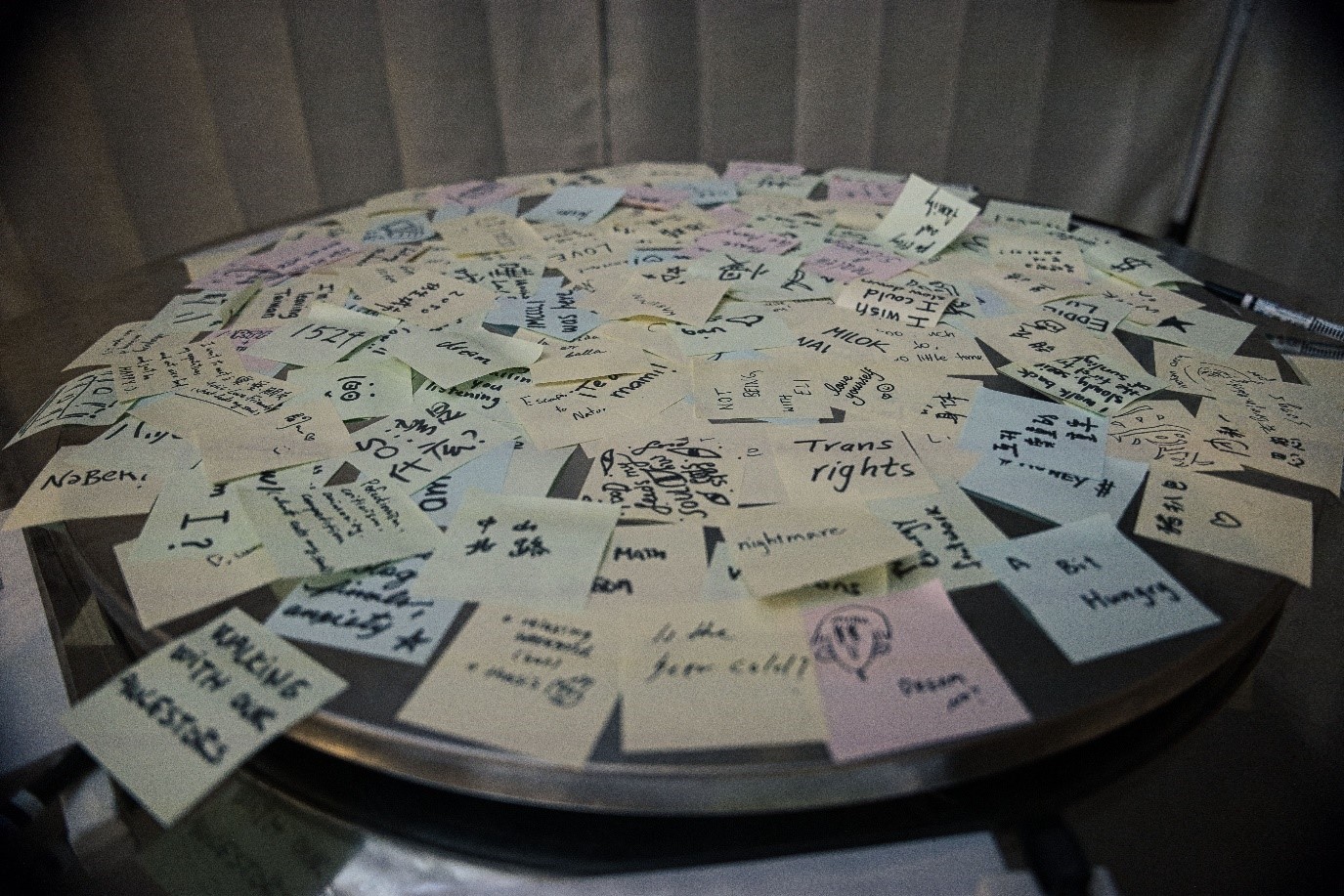
Figure 8 The collection of traces in – living traces –. C-Lab, Taipei, Taiwan. November 2023.
– living traces –
Taking the form of an iconic Taiwanese night-market stall, – living traces – invites the audience to slowly discover the various media and experiences held within. First, they encounter the curtained beige pavilion, partially hiding its content and evoking curiosity. Stepping in, the circular aluminium table and lazy Susan surrounded by red plastic stools invites visitors to sit. The table is set. However, there is no cutlery here, no food. Sticky notes and pens adorn each place alongside a laminated menu, featuring questions instead of dishes. Written notes cover the turntable in the centre. With a wandering look between the open-ended questions on the menu, visitors are invited to add their traces to those collected on the turntable. As the curious gaze detaches from the table, the audience discover projections illuminating the ceiling of the pavilion. Words and symbols from the turntable becoming a cloud of interconnected points in a slow choreography of moving links, orchestrated by a computer system. When time comes to leave the audience pass a small counter, where a receipt machine invites to "check out". At the push of a button, a receipt is printed. Offering the audience to take the collated traces of the table with them.
Surrounded by traces; which traces are yours? Where do they connect?

Figure 9. Facets of – living traces –
This interactive installation invites visitors to partake in the creation of a shared experience—a collective memory. Through our explorations and discussions, we found this to be one of the fundamental glues for shared cultural existence and transcultural exchange. Defining such collective memory holistically; encompassing many formats from the physical connection of events within the same locale, period or system to the less tangible connection of similar histories, beliefs and feelings. The system of – living traces – is intentionally open-ended, ready to become what visitors make it. Whether that is through direct discussion with other visitors around the table, quietly leaving a trace as an individual or passively standing in the space before leaving. We are interested in the ways in which all these modes of engagement—and everything in between—impacts the larger system of an ongoing, ever-changing shared experience.
The influence of the TC program and our field research trips resound within the work. For example, we intentionally left the mode of engagement open and ambiguous, in order to prompt visitors to position themselves within the space and system—echoing the thoughts from Orchid Island.
Ultimately, – living traces – attempts to replicate the complexity of cultural relations on a small scale through the idea of collective memory, shared experience, and influence; pulling many questions into focus.
We endeavour to continue working together on this project as a group and are currently looking to expand and exhibit – living traces – in other national and cultural contexts, in order to further its discussion and dissection of the transcultural.
Beyond Practice and Study
While many of the tangible benefits of TC came from the lectures, discussions, field trips and works we produced it didn’t stop there. The countless hours spent in the group were incredibly enriching. Despite our backgrounds being in different media, from different nations and often using different languages, sharing time and space on this program blossomed into a rich melting pot. Sharing moments, ideas, beliefs, crafts, and memories together. Ultimately, drawing us together as friends. Of course, a number of those friendships would be destined to end with the course—but plenty of them will live on for years to come. And, with us all being artists seeking collaboration, many will surely resurface in future transcultural projects.
Beside friendships, I also learnt a lot of different methods that I am going to actively continue using. Working so intensively in such a diverse and talented group of individuals brought countless new methods and approaches to the fore. These methods range from team building and concept-finding exercises to practical artistic skills in both my own medium and others. Honestly, I have learned too many to count, and I have already begun applying many to my work.
Outcomes and Futures
TC23 has been a valuable, diverse, and truly enriching experience. It allowed me to travel to new parts of the world, become friends with talented young artists from different backgrounds and disciplines, learn new working methods and create two works I am proud of. Not only that, but it also offered endless opportunities for cultural exchange and thought-provoking debate. The program had a great balance of hands-on and hands-off teaching, through its fluctuating phases. All the while providing guidance and support in the background.
While its intensity and brevity certainly make the course full on, in its aftermath I can see a lot of what I learnt more clearly—that said, I’m sure I will continue to uncover the program’s many lessons for years to come. Currently, I not only plan on continuing working on – living traces – with my talented colleagues, but I hope to collaborate and spend more time with a number of the other artists from the course in the years to come. It had also whet my appetite further practical arts education across borders.
In all, the program has been a font of development, productivity, and friendship. Offering up an incredible amount of growth and opportunity all within a mere three-

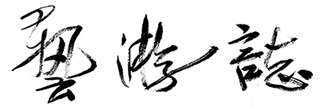 電子報-藝游誌
電子報-藝游誌